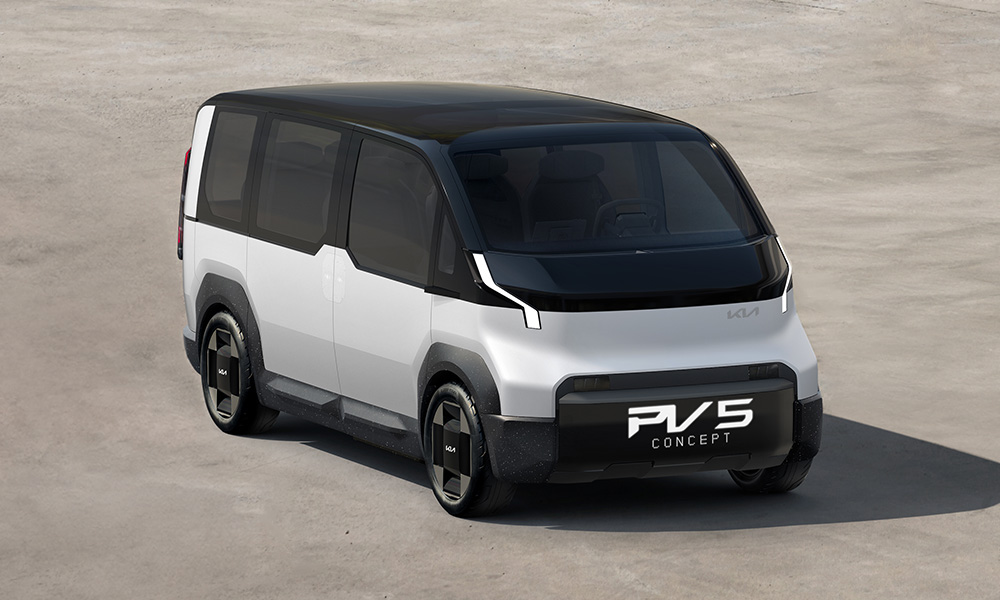The all-new Kia PV5 is gaining attention worldwide as a smart, modular electric van designed to redefine commercial transport. Revealed as part of Kia’s PBV (Platform Beyond Vehicle) strategy, the PV5 is much more than just an electric van. It’s built with flexibility in mind, targeting logistics companies, ride-sharing platforms, and city-based fleet operators. The Kia PV5 aims to be the solution for tomorrow’s urban mobility, combining electric efficiency with smart design and customization.
With the global shift toward cleaner commercial vehicles, the Kia PV5 presents itself as a purpose-built electric van that adapts to multiple business needs. Its modular structure, tech-rich cabin, and range of body styles make it one of the most versatile electric offerings in the pipeline.
Design That Follows Function
The design language of the Kia PV5 is clean and futuristic. The boxy profile is intentional, maximizing cargo volume and passenger space. The front-end features a wide LED light bar and a smooth grille panel, reinforcing its EV identity. The proportions are smartly balanced, offering compactness for tight urban streets and enough room for commercial loads.
The large sliding doors on either side improve accessibility for both passengers and packages. Kia has also used recyclable materials across panels and interior trims, supporting the brand’s sustainable vision. With a flat floor and high roofline, loading and unloading become quicker and easier.
Built on a Modular EV Platform
The Kia PV5 is based on Kia’s eS platform, which is a scalable skateboard-type chassis developed specifically for PBVs. This platform supports different body types without altering the underlying structure. That makes the PV5 highly adaptable.
This platform benefits include:
- Flat floor and low step-in height
- Easy swapping of body modules (cargo, passenger, ride-share)
- Centralized battery position for better weight balance
- Improved interior space utilization
This flexibility is what makes the Kia PV5 a standout choice for various urban and commercial applications.
Multiple Variants for Diverse Needs
The PV5 won’t come as a one-size-fits-all model. Kia plans to launch multiple body styles under the PV5 badge. These may include:
- PV5 Cargo: Optimized for last-mile delivery services
- PV5 Pickup: Open cargo bed version for utility transport
- PV5 Robotaxi: Equipped with autonomous driving features
- PV5 Shuttle: Passenger version for ride-sharing and group travel
- PV5 Van+: A slightly larger version with higher roof and more interior volume
Each version is expected to come with software and tech packages suited to its specific function. For example, the robotaxi may integrate lidar sensors and advanced driver-assistance systems, while the cargo version may offer real-time fleet tracking tools.
Battery Range and Charging Capabilities
While Kia hasn’t released final numbers yet, the PV5 is expected to offer competitive range figures for its class. Given its urban focus, a 300–350 km real-world range would be ideal. Fast charging support is a given, as time matters for fleet operators.
Expected battery and charging specs:
| Feature | Specification |
|---|---|
| Battery Type | Lithium-ion, LFP or NMC |
| Estimated Range | 300–350 km (city use) |
| Charging Time (DC fast charge) | 0–80% in under 40 mins |
| Charging Port | CCS2 standard |
The focus is on keeping downtime minimal. For logistics fleets or shared mobility services, fast turnarounds between charges are critical, and the PV5 seems built for this challenge.
Technology and Connectivity
The Kia PV5 will be fully loaded with smart tech designed for efficiency and fleet control. Kia’s Connected Car Navigation Cockpit (ccNC) is expected to make an appearance, along with cloud-based telematics for fleet managers.
Some tech highlights may include:
- Digital instrument cluster with route optimization
- Voice-guided fleet communication
- OTA (Over-the-Air) software updates
- Smart HVAC for passenger comfort
- Vehicle-to-Everything (V2X) communication
For robotaxi variants, Kia may integrate Level 4 autonomous tech via partnerships with firms like Motional. This would make the PV5 a zero-driver, app-controlled ride experience in selected cities.
Interior Practicality and Comfort
The cabin of the Kia PV5 is functional but thoughtfully designed. There’s ample storage across the dashboard and under-seat areas. The seating is upright and supportive, with variants offering either fixed benches or foldable seating depending on usage.
In cargo variants, the rear section will have a completely flat floor, reinforced walls, and anchor points for securing packages. In ride-sharing versions, expect ambient lighting, USB charging ports, and smart displays for passengers.
The driver’s cabin is futuristic with a steering column-mounted screen, drive-by-wire controls, and touch panels for HVAC and navigation. Everything is kept minimal yet useful, reducing distractions during driving.
Sustainability Focus in Materials
Kia is leaning into eco-friendly production with the PV5. The vehicle uses recycled plastic for interior panels, bio-based upholstery, and sustainable paints. Even the packaging for delivery models is being developed with reusable pallets and modular bins.
By building this electric van with sustainability from the ground up, Kia is aligning it with future environmental norms expected in Europe, the US, and even parts of Asia.
Expected Global Rollout and Production Plans
Kia has announced a dedicated PBV factory in Hwaseong, South Korea, where the PV5 will enter mass production by late 2025. Exports are expected to begin shortly after, targeting key urban markets in Europe and North America first.
India may see the PV5 later depending on commercial EV infrastructure and demand from fleet partners. If battery-swapping networks grow in India, the PV5 Pickup or Cargo could be localised as a delivery-focused EV.
FAQs About Kia PV5
What is the Kia PV5?
It is a modular, electric van designed for commercial use. It supports multiple body styles like cargo, shuttle, and robotaxi formats.
When will the PV5 launch globally?
Kia plans to begin production by the end of 2025, with global rollouts expected in early 2026.
What is the expected range of the PV5?
The PV5 may offer a range of around 300 to 350 km depending on usage and variant.
Will the PV5 come to India?
There’s no official confirmation yet. Kia may introduce it based on demand from logistics or ride-sharing companies.
Can the PV5 be used for personal ownership?
While it’s mainly designed for commercial applications, Kia may offer passenger versions suitable for fleet owners or large families.
Does it support fast charging?
Yes. The Kia PV5 will support DC fast charging for quicker turnaround, making it viable for high-use urban environments.










